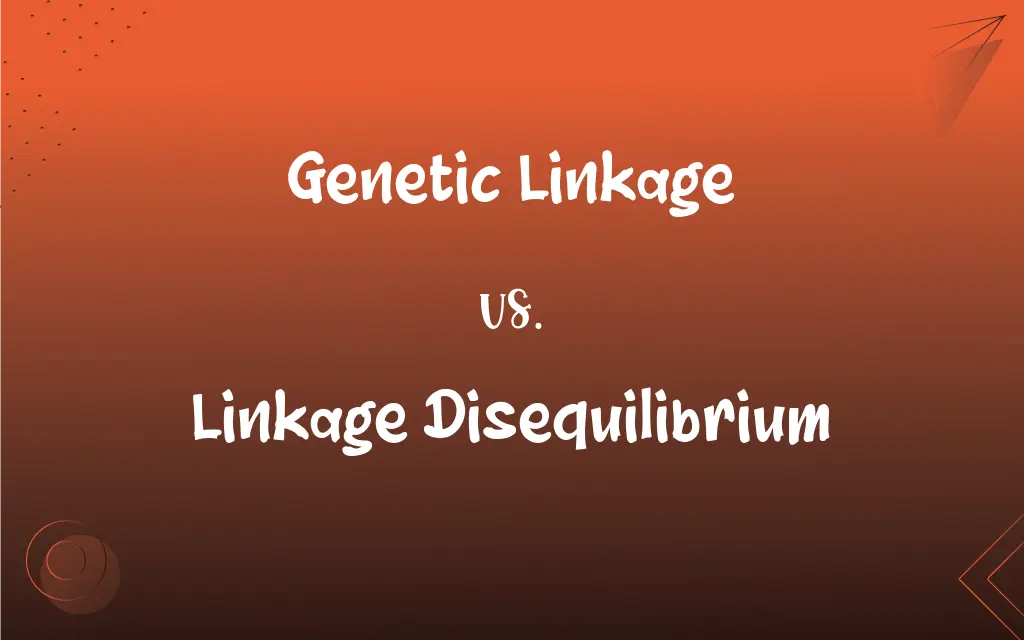Genetic Linkage vs. Linkage Disequilibrium: What's the Difference?
Edited by Aimie Carlson || By Janet White || Published on March 26, 2024
Genetic linkage refers to genes located close together on the same chromosome that tend to be inherited together, while linkage disequilibrium describes a non-random association of alleles at different loci.

Key Differences
Genetic linkage occurs when genes are located near each other on the same chromosome, leading to their co-inheritance during meiosis due to the reduced likelihood of recombination between them. Linkage disequilibrium, however, involves the non-random association of alleles at different loci, often due to historical or evolutionary processes, rather than physical proximity on a chromosome.
Linkage disequilibrium can result from genetic linkage when alleles do not assort independently due to their close proximity on a chromosome, but it can also arise in populations due to factors like genetic drift, selection, or population structure, which affect allele frequencies. Genetic linkage is a physical property of genes based on their locations, affecting which alleles are inherited together.
In genetic linkage, the closer two genes are on a chromosome, the greater the likelihood they will be inherited together, which is quantified by the recombination frequency. Linkage disequilibrium does not directly consider the physical distance between genes but rather measures how often certain allele combinations occur together more or less often than expected by chance.
Recombination can disrupt genetic linkage over generations by separating linked genes, leading to independent assortment. In contrast, linkage disequilibrium can be maintained or even generated by selection for specific allele combinations that confer an adaptive advantage, and it can persist across generations until recombination or other forces break down the non-random association.
Genetic linkage maps are constructed based on the frequencies of recombination between markers, indicating the physical arrangement and relative distances of genes, studies of linkage disequilibrium often focus on the correlation between genetic variants across a population to identify regions under selection or associated with diseases, without necessarily implying physical proximity on chromosomes.
ADVERTISEMENT
Comparison Chart
Definition
The physical co-location of genes on the same chromosome, leading to their co-inheritance.
The non-random association of alleles at different loci, not necessarily on the same chromosome.
Cause
Physical proximity on a chromosome, reducing the likelihood of being separated during recombination.
Various, including genetic drift, selection, and population structure, not just physical proximity on a chromosome.
Measurement
By the frequency of recombination between loci; lower frequencies indicate closer linkage.
By the correlation between allele frequencies at different loci, irrespective of physical distance.
Implications for Inheritance
Genes that are closely linked tend to be inherited together unless separated by recombination.
Allele combinations at different loci are inherited together more or less often than expected by chance.
Impact of Recombination
Recombination can disrupt linkage by separating genes that were previously linked.
Recombination can reduce linkage disequilibrium by breaking up non-random allele associations.
ADVERTISEMENT
Genetic Linkage and Linkage Disequilibrium Definitions
Genetic Linkage
A factor in the predictability of trait inheritance.
Due to genetic linkage, predicting the inheritance of one trait could inform about another.
Linkage Disequilibrium
A tool for mapping genes associated with diseases.
Linkage disequilibrium mapping helped identify the gene associated with the condition.
Genetic Linkage
The tendency of genes close on a chromosome to be inherited together.
Because of genetic linkage, the two genes were almost always passed on together.
Linkage Disequilibrium
Affected by factors like population structure and mating patterns.
Population admixture introduced new patterns of linkage disequilibrium.
Genetic Linkage
Influenced by the frequency of recombination between genes.
Lower recombination frequencies indicated stronger genetic linkage between the markers.
Linkage Disequilibrium
The non-random association of alleles at different genetic loci.
The observed linkage disequilibrium suggested a recent selective sweep in the population.
Genetic Linkage
A key concept in understanding the inheritance of complex traits.
Studies of genetic linkage have elucidated the genetic basis of many diseases.
Linkage Disequilibrium
Can persist across generations, reflecting historical or evolutionary processes.
Linkage disequilibrium in the population was shaped by its bottleneck event.
Genetic Linkage
Determined by the physical proximity of genes, affecting their inheritance patterns.
Genetic linkage maps help trace the inheritance of linked traits.
Linkage Disequilibrium
Offers insights into the evolutionary dynamics of populations.
The study of linkage disequilibrium revealed insights into the population's evolutionary history.
FAQs
What factors contribute to linkage disequilibrium?
Factors contributing to linkage disequilibrium include genetic drift, selection, population admixture, and mating patterns, among others.
What is genetic linkage?
Genetic linkage refers to the tendency of genes located close together on the same chromosome to be inherited together due to their proximity reducing the likelihood of recombination.
How do genetic linkage and linkage disequilibrium differ?
Genetic linkage is based on physical proximity of genes on a chromosome affecting their inheritance, while linkage disequilibrium refers to non-random allele associations, not necessarily due to physical proximity.
What causes genetic linkage?
Genetic linkage is caused by the physical location of genes on the same chromosome, which makes it less likely for them to be separated during recombination.
How is genetic linkage measured?
Genetic linkage is measured by the frequency of recombination between loci; closer linkage corresponds to lower recombination frequencies.
How is linkage disequilibrium measured?
Linkage disequilibrium is measured by the correlation between allele frequencies at different loci, regardless of their physical distance.
What is linkage disequilibrium?
Linkage disequilibrium describes the non-random association of alleles at different loci, which can be due to various factors, including selection and population structure.
Can linkage disequilibrium occur without genetic linkage?
Yes, linkage disequilibrium can occur without genetic linkage due to factors like selection or population structure creating non-random allele associations.
Why is genetic linkage important in genetics?
Genetic linkage is important for understanding inheritance patterns, constructing genetic maps, and studying the genetic basis of diseases.
How can linkage disequilibrium aid in gene mapping?
Linkage disequilibrium can help in gene mapping by identifying regions where non-random allele associations suggest the presence of disease-associated genes.
How does recombination affect genetic linkage?
Recombination can disrupt genetic linkage by separating genes that were previously linked, leading to independent assortment.
What is a linkage map?
A linkage map is a genetic map based on recombination frequencies that shows the relative positions of genes on a chromosome.
Why is linkage disequilibrium important in population genetics?
Linkage disequilibrium is crucial for mapping disease genes, understanding population history, and studying evolutionary processes.
How do evolutionary processes influence genetic linkage and linkage disequilibrium?
Evolutionary processes like mutation, selection, genetic drift, and gene flow can influence both genetic linkage and linkage disequilibrium by altering allele frequencies and recombination patterns.
How does recombination affect linkage disequilibrium?
Recombination can reduce linkage disequilibrium by breaking up non-random allele associations over time.
Can genetic linkage be used to map genes?
Yes, genetic linkage is used in linkage mapping to locate genes on chromosomes based on their inheritance patterns.
How does population structure affect linkage disequilibrium?
Population structure can affect linkage disequilibrium by creating subpopulations with different allele frequencies, which can lead to or maintain non-random associations.
What is a genetic marker?
A genetic marker is a DNA sequence with a known location on a chromosome that can be used to identify individuals or species and to study inheritance patterns.
How do mutations affect genetic linkage?
Mutations can introduce new alleles at linked loci, potentially affecting the inheritance patterns and recombination frequencies observed.
Can linkage disequilibrium indicate recent selection in a population?
Yes, high levels of linkage disequilibrium in a region can indicate recent selection, as selected alleles and their linked neighbors increase in frequency together.
About Author
Written by
Janet WhiteJanet White has been an esteemed writer and blogger for Difference Wiki. Holding a Master's degree in Science and Medical Journalism from the prestigious Boston University, she has consistently demonstrated her expertise and passion for her field. When she's not immersed in her work, Janet relishes her time exercising, delving into a good book, and cherishing moments with friends and family.
Edited by
Aimie CarlsonAimie Carlson, holding a master's degree in English literature, is a fervent English language enthusiast. She lends her writing talents to Difference Wiki, a prominent website that specializes in comparisons, offering readers insightful analyses that both captivate and inform.
































































